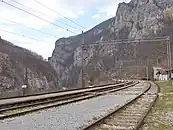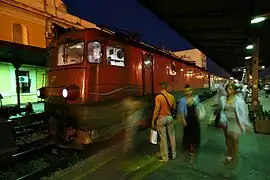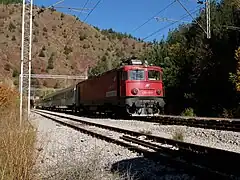| Belgrade–Bar railway | |
|---|---|
 ŽCG 461 039 at Lutovo station | |
| Overview | |
| Status | Active |
| Owner | Serbian Railways, ŽICG |
| Termini | |
| Service | |
| Operator(s) | Serbian Railways, ŽPCG |
| History | |
| Opened | 1976 |
| Technical | |
| Line length | 476 km (296 mi) |
| Number of tracks | 1 |
| Track gauge | 1,435 mm (4 ft 8+1⁄2 in) standard gauge |
| Electrification | 25 kV, 50 Hz AC |
| Operating speed |
|
The Belgrade–Bar railway (Serbian: Пруга Београд–Бар, romanized: Pruga Beograd–Bar) is a railway connecting the Serbian capital of Belgrade with the town of Bar, a major seaport in Montenegro.
Overview

The Belgrade–Bar railway is 476 kilometres (296 mi) long, of which 301 km (187 mi) is in Serbia and 175 km (109 mi) is in Montenegro. It is standard gauge and electrified with 25 kV, 50 Hz AC for its entire length. It passes through 254 tunnels of total length of 114,435 m (375,443 ft) and over 435 bridges (total length 14,593 m (47,877 ft)). The longest tunnels are "Sozina" (6.17 km or 3.83 mi), and "Zlatibor" (6.169 km or 3.833 mi). The biggest and the best-known bridge is Mala Rijeka Viaduct, 498 metres (1,634 ft) long and 198 m (650 ft) above ground level.
The highest point of the railway is 1,032 m (3,386 ft) above mean sea level, at the town of Kolašin. The railway descends to 40 m (130 ft) above mean sea level at Podgorica in a relatively short distance, resulting in a gradient of 25‰ on this section.
A short 9 km (6 mi) section of the railway passes through Bosnia and Herzegovina, where there is a station at Štrpci.
When the line was completed in the late 1970s, the trip between Belgrade and Bar took approximately 7 hours. Today, the same trip takes around 11 hours due to speed restrictions necessitated by poor track conditions and border controls at Bijelo Polje.[1]
Stations
.png.webp)
History
.jpg.webp)
The decision to build the railway connection between Belgrade and Bar was made in 1952, as a national project of the Socialist Federal Republic of Yugoslavia. However, the construction was passed to the constituent Republics, SR Serbia and SR Montenegro, to build on their own.
The sections of the railway were completed as follows:
- Resnik – Vreoci in 1958
- Podgorica – Bar in 1959
- Vreoci – Valjevo in 1968
- Valjevo – Užice in 1972
- Užice – Podgorica in 1976
The construction works were concluded on 27 November 1975, by joining the railway tracks south of Kolašin. The railway was opened on 28 May 1976. Electrification was completed at the end of 1977.
Maintenance of the Belgrade–Bar railway suffered from chronic underfunding during the 1990s, which has resulted in the railway deteriorating and becoming unsafe. This culminated in the Bioče derailment, when a passenger train derailed, causing the deaths of 47 passengers. As a result, efforts are being made to thoroughly reconstruct the railway.
The Serbian part of the railway was targeted several times by NATO during its bombing campaign in 1999, seriously damaging portions of the railway.[2] Also, the small section that passes through Bosnia and Herzegovina was blown up by SFOR ground forces.[3] All of this damage was later repaired.
In 2016, Serbia started a thorough reconstruction of its portion of the line in order to restore its original maximum speed of 120 kilometres per hour (75 mph). The first section, between Belgrade and Valjevo (27% of the Serbian part of the line) was completed in 2017, with speeds of up to 120 km/h, however Serbian Railways Infrastructure later stated trains reached speeds of 100 km/h, causing some confusion as to what the maximum speed actually is.
Gallery

 Bijelo Polje railway station on the Belgrade–Bar railway.
Bijelo Polje railway station on the Belgrade–Bar railway.
 ŽS 461-013 on the Belgrade–Bar railway.
ŽS 461-013 on the Belgrade–Bar railway..jpg.webp) A ŽS 461 at Vrbnica on the border of Serbia and Montenegro.
A ŽS 461 at Vrbnica on the border of Serbia and Montenegro.
See also
- Serbian Railways
- Rail transport in Montenegro
- Tito's Blue Train
- JŽ series 461 commonly operated over the Bar-Belgrade line. Based on a Swedish design.
- JŽ class 412/416 Latvian EMU
- CAF Civity EMU
- JŽ 661 Shunter/Montecargo
- JŽ 644 Shunter/Montecargo
- JŽ 744 (none of them is active) Shunter/Montecargo
- JŽ D66/761s (DB Class V 200 based engines) of Tito's Blue Train.
- JŽ 666s (EMD JT22CW-2s) of Tito's Blue Train
References
- ↑ "Border crossing points". Government of Montenegro. Government of Montenegro. Retrieved 19 July 2023.
- ↑ "14. April – oštećena pruga Beograd–Bar, gađan "Krušik"".
- ↑ "Kako je minirana pruga Beograd - Bar". Archived from the original on 2016-03-04. Retrieved 2021-05-06.
External links
- Belgrade to Bar railway, Seat 61
- The Guardian
